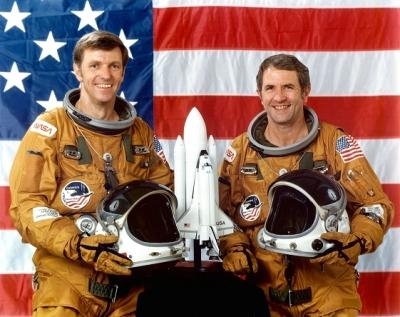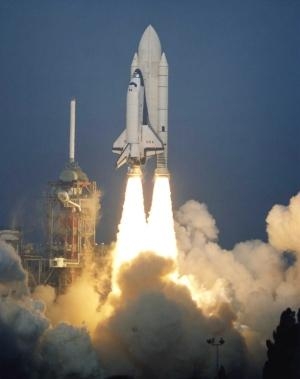I WAS THERE… Only This Time I Was Closer - Part 2
By Wes Oleszewski
When last we left me at KSC, the space shuttle Columbia was
poised for its second launch and I found myself as an NIP, (Non-
Important Person) observing at a place called Bunker number 7 among
a group of VIPs. One of those was a very kind lady who took pity on
me, the impoverished college student, and gave me an STS-2 souvenir
postal cover to send my folks. Inside the cover was a small note
card sized sheet that was blank on one side and gave some common
space shuttle facts on the other side. I took a moment to scribble
a note to my folks on the blank side, also denoting that the
countdown was currently at T-2:00:08 and counting. Dropping the
note card into the cover I happily trotted to the portable post
office and mailed the envelope that one day may become "… a
collector's item."

Joe Engle and Dick Truly were strapped aboard the Columbia at
about that same time. To most of the public they were unknown
rookies who had never flown before and space, but to us spaceflight
buffs these two pilots were far from being rookies. Engle, in fact,
was already an astronaut who had flown in space before even he
joined NASA. He had flown the X-15 a total of 50 times between 1963
and 1965 with three of those missions reaching altitudes above 50
miles. This qualified him to wear astronaut wings. Additionally
Engle and Truly actually had a one up on the first shuttle crew,
Young and Crippen. To date Young and Crippen had performed one
landing of a shuttle orbiter, but the crew of Engle and Truly had
already performed two landings of a shuttle order. In 1977 Engle
and Truly were two of the four pilots who flew the space shuttle
Approach and Landing Tests with the orbiter Enterprise.
Glued to assorted portable radios and at least one portable TV,
we monitored the count as it was broadcast by various local news
stations. When the count neared the planned time to come out of the
scheduled T-9:00 hold, Launch Director George Page elected to take
a moment before resuming the count. It was his intention to keep
his controllers cool, take a deep breath and make sure they were
doing everything right. That little bit of extra hold time,
however, really annoyed some of the newsman- of course that meant
nothing to the launch director. After just a few short minutes the
count resumed in the Columbia had the undivided attention of
several million of people around the world.
After the previous week’s scrub nearly everyone seemed to
be hypersensitive to the T-31 second mark in the count. As that
point came and went a cheer and applause echoed through the crowd.
Apparently everyone seemed to have the perception that if you got
past that moment in the count you were good to go. In fact, I
noticed for many years that passing the T-31 seconds mark and the
start of redundant sense sequencing tended to draw a smattering of
applause. The cold hard truth was that it meant nothing more than
detection of problems were turned over to the computer and thus,
anything that would keep you from flying could not be detected
several million times faster then when you are off the sequencer.
So there was really nothing to cheer about.

In the final seconds prior to the launch I went and stood on the
bleachers with the real VIPs. The guy standing next to me was armed
with a Super 8 movie camera. At main engine start he raised the
camera to his eye, pulled the trigger and began filming. I guess he
didn't expect what those of us who had been there for the previous
shuttle launch had already experienced. A few moments after SRB
ignition the shuttle reached out and grabbed us compelling everyone
scream "GO BABY, GO!" A moment later I glanced over to see the guy,
mesmerized and standing there looking up at the departing shuttle,
his mouth hanging open and his hand with the running movie camera
down at his side- filming the bleachers. I nudged him with an elbow
and got his attention then pointed down at the camera."OH!" He said
as he returned to filming the launch. For some reason the shuttle
did that kind of stuff to you.
A little more than 8 minutes later the United States had
accomplished something never before done- they had reused a manned
spaceflight vehicle. Columbia was safely in orbit and soon we were
safely back aboard the bus- feeling that strange sense of pride, as
if we had launched Columbia ourselves.
Although STS-2 made it safely to orbit, this was still a test
flight and things were still expected to go wrong… thus they
did. One of the three fuel cells on board the orbiter failed early
in the mission. That fuel cell was shut down and isolated. In the
process of doing that mission control was forced to alter the
mission profile from a five-day flight to a two day flight. The
crew elected to double their work efforts and managed to accomplish
nearly 90% of their scheduled tasks in the shortened mission. Then
they set the Columbia up for landing at Edwards Air Force Base on
November 14th.

One of the landing objectives in the STS-2 test flight was to
attempt the first crosswind landing of the Columbia. Mission
planners had their fingers crossed that the winds for this landing
would be a bit stronger than the calm conditions that existed in
the previous shuttle landing. The old saying of "be careful what
you ask for, because you just might get it," held true for STS-2.
NASA planners got their wind-in fact, they got a lot of wind. As
the orbiter was coming into a reentry blackout, John Young was busy
performing landing approaches in the Shuttle Training Aircraft on
the crosswind runway. On his final pass to that runway he found the
winds to be a direct crosswind at 12 to 19 knots- and that was far
more than NASA was comfortable with for the test. They changed the
runway, but that meant that when the orbiter made its turn to final
approach at altitude, it would be turning into a 90 knot wind. Some
quick recalculation's of energy management on final approach were
required. Additionally, one of the tests was to fly this portion of
the approach on the automatic flight control system and that meant
that when turning into a 90 knot wind, the autoland would try to
over bank and pull a few more G’s the NASA was comfortable
with. So, Engle would simply have to skip that portion of the test,
come out of the autoland mode, make the turn on manual and at his
option return to autoland.
By the time STS-2 was on its final approach the winds on the
surface were gusting to over 25 knots. Of course this crew had
already made two previous free flight landings and approaches at
Edwards in the orbiter Enterprise and were already the most
experienced landing crew in the astronaut office. Engle and truly
guided the Columbia to a perfect landing and they along with all of
NASA succeeded in accomplishing yet another never before performed
technical achievement. For the first time a manned space vehicle
had been successfully re-launched, re-landed and re-used.

Now, 30 years after the flight of STS-2, I still have that
"collector's item" postal cover that I sent to my folks. I figure
it’s worth about $1.75. And so to celebrate that event I took
it out, sat it on my desk and remembed the launch and the kindness
of that nice lady who took pity on an impoverished college kid that
day. I even bought some cheap strawberry preserves, just so I could
make a well-squished peanut butter sandwich. It strikes me that at
every space shuttle launch, in fact every manned spaceflight
launch, pleasant people gather in a completely joyful atmosphere-
people just like that lady. You can ask yourself how often is it
that anywhere in America crowds of people, upward of a million at a
time, from all different backgrounds, gather in one place and they
are all happy, proud, pleasant and friendly. Without any taking of
sides, protesting, political smears, hatred, vilification, damage
and violence- they come only to witness and celebrate the peaceful
advancement of human civilization. This perhaps is the most
overlooked benefit of United States human spaceflight. With the end
of the shuttle, this witnessing and celebration the spectacle of
that peaceful advancement of our civilization is quite likely to be
the one thing that we will all miss the most in the years
ahead.
 ANN's Daily Aero-Linx (04.16.24)
ANN's Daily Aero-Linx (04.16.24) Aero-News: Quote of the Day (04.16.24)
Aero-News: Quote of the Day (04.16.24) Airborne 04.10.24: SnF24!, A50 Heritage Reveal, HeliCycle!, Montaer MC-01
Airborne 04.10.24: SnF24!, A50 Heritage Reveal, HeliCycle!, Montaer MC-01 Airborne 04.12.24: SnF24!, G100UL Is Here, Holy Micro, Plane Tags
Airborne 04.12.24: SnF24!, G100UL Is Here, Holy Micro, Plane Tags Airborne-Flight Training 04.17.24: Feds Need Controllers, Spirit Delay, Redbird
Airborne-Flight Training 04.17.24: Feds Need Controllers, Spirit Delay, Redbird






